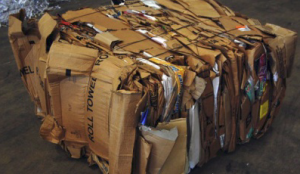
The plastic industry has made no secret of the fact that it would like to burn over a million tonnes of currently “non-recycled” plastics in Ontario alone[1] . In strategic terms this would remove a major solid waste problem (some 73% of residential plastic packaging in Ontario, for example, ends up in landfill)[2] , while at the same time provide a feedstock for the energy-from-waste (EFW) plants the plastics industry would like to see built. Better to burn the stuff and get some energy from it, rather than just send it to the dump, the argument goes.
It would be hypocritical of the paper industry to be opposed to energy-from-waste as a technology. After all, kraft paper mills convert parts of the tree that can’t be used to make paper into energy to power their operations; and several mills also use the residuals of municipal solid waste as an energy source. We will leave it to others to comment on the air pollution aspects of EFW plants, and on how much, if any, taxpayers’ money should be used to subsidise them.

Most boxes and cartons manufactured in Canada are 100% recycled content.
Our major concern in this debate is what can be called the paper feedstock issue. The Canadian paper packaging industry is highly dependent on paper recovered from the back of factories and supermarkets and from households. Most boxes and cartons manufactured in Canada are 100% recycled content. Our mills are generally located in urban areas to capitalise on nearby supplies of recyclable feedstock. Paper materials represent almost 70% of the dry recyclables generated by Ontario households, and almost 80% of all that is recovered for recycling through the province’s Blue Box system[3] .
If anything happens to jeopardise this supply of recovered paper, we have a concern. If local supplies go down, we have to find recovered paper elsewhere, at higher prices, and with a possible cumulative effect of rendering paper products less competitive in the marketplace, in some cases, with certain plastic products that are recycled less easily.
Which brings us to the question of narrowing down exactly what materials, and how much of it, is needed to justify the economics of an EFW plant. Is the tonnage of currently “non-recycled” plastic materials enough? Will it have to be supplemented by paper materials? If so, which ones, and how many tonnes? What will be the impact on the paper industry’s fibre supply, and on the economics of the Blue Box? Do the materials used in an EFW plant count as “recycling” or “diversion”? What would be the impact on the Blue Box funding model if suddenly 82% of residential plastic packaging is deemed to be “recycled” through EFW or “diverted” rather than landfilled?[4] Lots of questions. Not many answers.
[1] Residential and IC & I Disposal of Plastics, Tables 2 and 3, pages 11-12, Energy and Economic Values of Non-Recycled Plastics (NRP) Currently Landfilled in Canada, M.E. Haight and N. Antadze, University of Waterloo, December 2012, commissioned by the Canadian Plastics Industry Association, CPIA press release of Jan. 18, 2013.
[2] Stewardship Ontario, Table 1: Generation and Recovery (2012 data).
[3] Ibid.
[4] Household generation of plastic film, laminants, polystyrene and other plastics together with PET and HDPE bottles currently landfilled, Stewardship Ontario, ibid.

great article John
In an EPR program how would the fees for ‘non recycled’ plastic materials be calculated? Would this material be collected in the Blue Box and made into engineered fuel or left in the garbage? Will ‘non-recycled’ plastics become the norm and efforts to make packaging with a recyclable end of life solution become a non issue? Too many questions must be answered before we light the match under this pile. Keep raising the questions John, one day we may get the answers!